Der Blaue Reiter – Unveiling the Mastery Behind The Blue Rider
What was Der Blaue Reiter, and what interesting concepts did this collective explore? Spearheaded by iconic Expressionist artists Wassily Kandinsky and Franz Marc, the famous Blue Rider collective launched themselves in the early 20th century as a means to convey the spirituality of their practices while exploring modern notions on color and intuitive expression in painting. In this article, we will examine the visual languages of the Der Blaue Reiter group while looking at their origin, their theories on art, and a few signature artworks from the group. If the intersections of music, color, and spirituality interest you, then we recommend that you stick around to learn more about this famous German Expressionism group!
Contents
The Blue Riders of German Expressionism
What is German Expressionism, who were The Blue Riders, and what did their art look like? The Blue Riders were a group of 20th-century artists who belonged to the German Expressionist Movement. The first half of German Expressionism was expressed in the collective known as “the bridge” or Die Brücke and was spearheaded by Ernst Ludwig Kirchner around 1905 in Dresden.
The movement was essentially a rejection of Western traditions in art and was a European approach to exploring and developing modern art.
As one of the developments of the movement, the Blue Riders group was made up of painters, graphic designers, writers, and art theorists who sought to change the way modern art looked and how spirituality could be found in painting. The movement that the Blue Riders group was rooted in, German Expressionism, was a movement that emerged to emphasize the experience of the artist on an emotional level as opposed to the simple replication of reality.
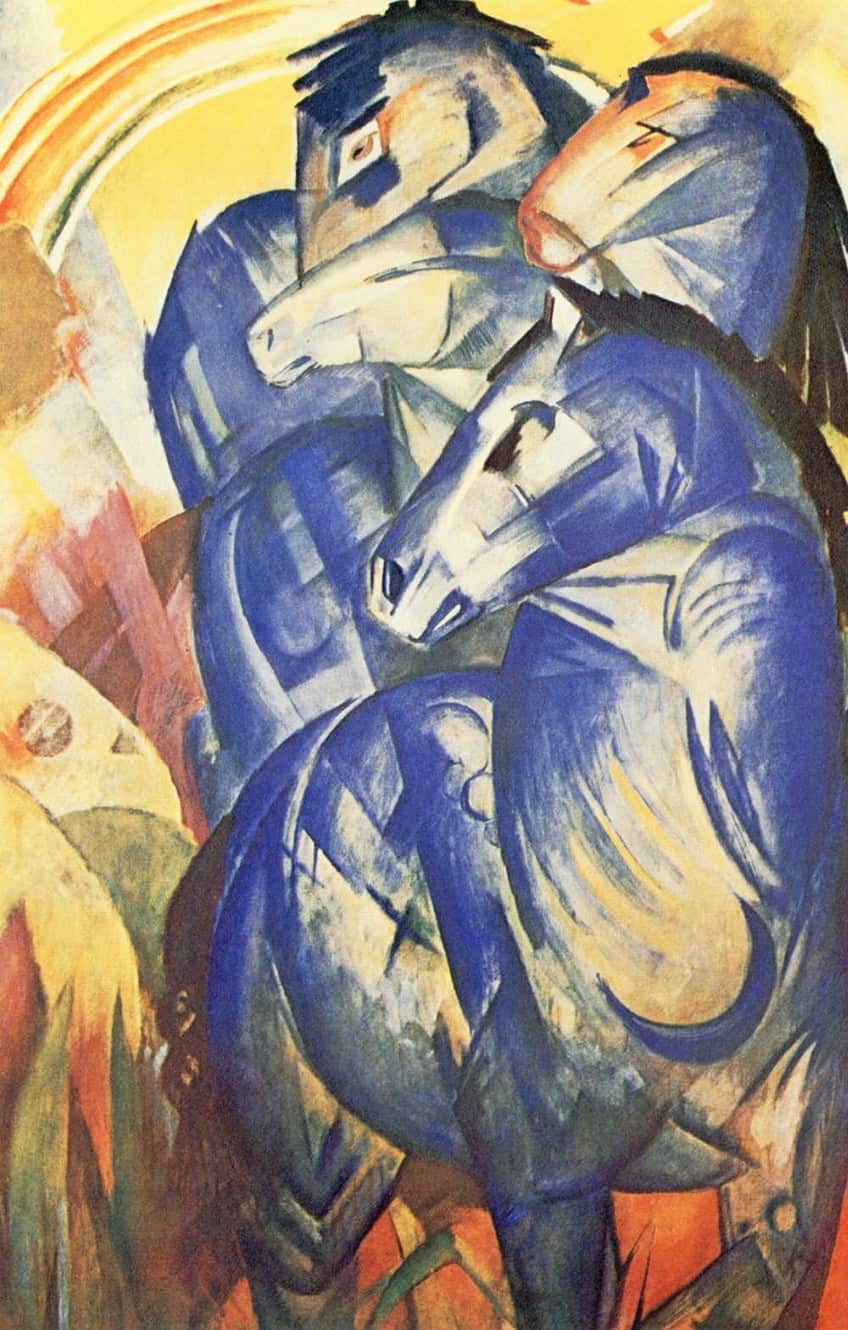
A few characteristics of German Expressionism include the use of gestural marks, vivid colors, and simplified forms and shapes. The movement was also founded on the exploration of certain dominant themes in modernity such as nudity as a signifier of raw emotion, solace, emotionally-charged portraits, and the many other expressive fears and desires of the early 20th century. Themes tackled in German Expressionism were characterized by their dark nature and visual distortions that reflected the inner turmoil of the artist. The two leading groups of artists who led the German Expressionist movement were Die Brücke and Der Blaue Reiter.
Ideated in 1911, Der Blaue Reiter Almanach was published in the following year and contained around 14 influential articles with illustrations and reproduced artworks that expressed the creative inspiration sourced by The Blue Riders group.
Known as De Blaue Reiter in German, the famous Expressionist group was founded by two key modern artists, namely, Franz Marc and Wassily Kandinsky. The duo joined hands with other emerging avant-garde artists in Munich, Germany, in 1909 to establish the Neue Künstlervereinigung München, also known as the New Artist Association. This initial group was founded as a secessionist group to explore other art styles and approaches that differed from the mainstream Eurocentric styles of the time. The style shared between these artists included visual languages from Symbolism and Fauvism, which influenced the group. German Expressionism thus went on to influence many significant aspects of society in the 1900s, from cinema to architecture and printing.
Defining Der Blaue Reiter
One of the most important aspects of German Expressionism and sub-groups like Der Blaue Reiter is that artists of these groups emphasized their positioning on art and religion as connected, such that art-making was a deeper practice of soul work and surrender to one’s inner spiritual energy. As previously mentioned, the emergence of Der Blaue Reiter was rooted in its predecessor in Dresden 1905 called Die Brücke group.
This famous German Expressionist group was the first collective to actively promote the works of artists belonging to the Neue Künstlervereinigung München.
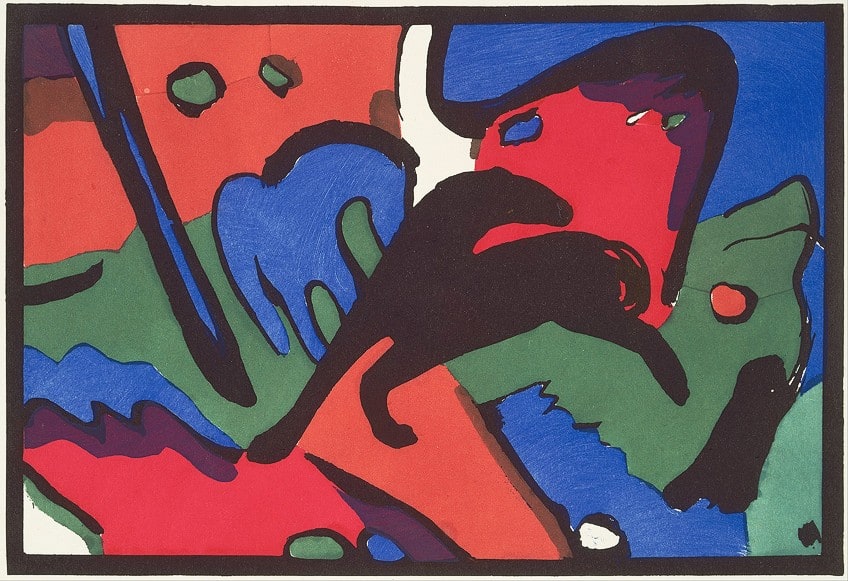
The difference between Die Brücke and Der Blaue Reiter was the differing goals of each group since both groups focused on the significance of bold colors shaped by Fauvism, but Der Blaue Reiter channeled early notions of color and Fauvist styles to explore spiritual associations and themes that extended beyond the realm of emotive persuasion. Another important difference between the groups is that Der Blaue Reiter embraced total abstraction to transcend the Western gaze and its Primitivist art styles.
Color Theory, Abstraction, and Music in Der Blaue Reiter
Der Blaue Reiter Almanach featured many essays in which Kandinsky detailed his ideas on color theory alongside his publication Concerning the Spiritual in Art. Kandinsky was known to establish specific values for colors with Eigenschaften or properties. For example, he described the color yellow as a color for excitement, joy, warmth, or perhaps annoyance.
Colors were associated with emotions and carried a strong spiritual significance, which can be seen in the group’s view of the color blue, which when approaching higher values, would deepen one’s feeling of calmness and serenity.
Franz Marc also worked on color theory and proposed specific symbolic values to different hues, some of which differed from Kandinsky’s valuation of meaning. For Marc, the color yellow was associated with feminine energy, and blue was tied to spirituality and masculinity. Music also played a pivotal role in shaping color theory in Der Blaue Reiter. For the group, music mirrored abstraction in the visual arts and was seen as a tool to evoke a deeper spiritual and emotional response through the different timbres of instruments.
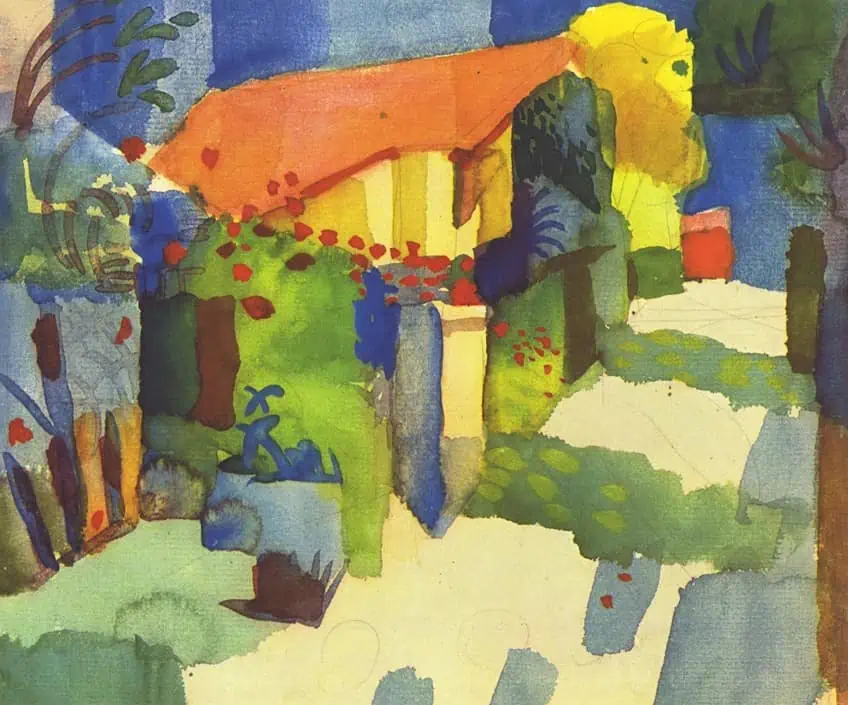
The idea that music has the power to evoke certain imagery in our mind’s eye was at the forefront of Der Blaue Reiter, especially in the work of Kandinsky. Music was a language to describe abstract art in a way that relied on sensations and the human reaction to sound to understand the abstraction of color and form. This direct relationship with sound and music was seen strongly in the paintings of Der Blaue Reiter, which also incorporated the work of composers like Schönberg and John Cage. An interesting observation by Rainer Maria Rilke on Paul Klee, who also played the violin, described Klee’s paintings as having qualities that indicated that the artist could depict transcriptions of music.
The group was thus deeply invested in musical form and the production of visual content that mirrored the sensations of music.
Kandinsky understood such productions as a synesthetic relationship that could be codified and described it as sound tones called Klangfarbe, where each color was assigned a volume and pitch. The Yellow Sound to the Almanach is an example of one of Kandinsky’s experiments with color and sound in theater, which formed part of his color-tone drama series.
Key Artists and Artworks of Der Blaue Reiter
The name of the group Der Blaue Reiter was derived from the work of Wassily Kandinsky whose motifs of the horse and its rider became a key symbol of the movement beyond its representational value. Franz Marc also used the subject of horses and other animals alongside color to embody rebirth.
The Blue Rider (1903) by Wassily Kandinsky
| Artist Name | Wassily Wassilyevich Kandinsky (1866 – 1944) |
| Date | 1903 |
| Medium | Oil on card |
| Dimensions (cm) | 55 x 60 |
| Where It Is Housed | Private collection, Zürich, Switzerland |
Russian-born artist and art theorist Wassily Kandinsky created The Blue Rider in 1903, which was soon to become the title of the Expressionist group he co-founded later. Kandinsky was raised in Moscow and studied art at Odesa Art School and later economics and law at the University of Moscow. After encountering the works of Claude Monet and his Haystacks series, Kandinsky was more motivated to throw himself into art. He took up painting lessons and by the age of 30, he moved to Munich, where he created The Blue Rider.
The painting portrays a horseman dressed in a blue cloak as he rides a white horse across a meadow. The most important aspect of the work is the color blue, which held much significance for the artist.
It was strongly tied to his beliefs in the spiritual world, as a symbol of his abstract connection to the human soul via art, color, and music. What makes this work even more special in the artist’s portfolio is that it represents his transition from Impressionist styles to a more Abstract and Modern style. Kandinsky was taught by Franz von Stuck at the Munich Academy, but he was not immediately granted admission into the school and had already started learning art on his own.

Later on, Kandinsky would move on to explore geometric lines in conjunction with color and form to explore his notions on color theory, which was simultaneously inspired by the music he listened to. Between 1922 and 1933, Kandinsky also taught at the Bauhaus, which went on to influence the approaches of later modernists like Piet Mondrian and Josef Albers.
His spiritual influences included the mystic Madame Blavatsky, who promoted theosophy.
The theories from theosophy were founded on the idea that creation was a geometrical progression that started from a single point. Two publications, which echo these creative beliefs by Kandinsky include Concerning the Spiritual in Art (1910) and Point and Line to Plane (1926). Additionally, Kandinsky was also affiliated with the Blue Rose Symbolist Collective and a member of the Theosophical Society.
Self-Portrait I (1910) by Marianne von Werefkin
| Artist Name | Marianne von Werefkin (1860 – 1938) |
| Date | 1910 |
| Medium | Oil on canvas |
| Dimensions (cm) | 34 x 51 |
| Where It Is Housed | Städtische Galerie im Lenbachhaus und Kunstbau München, Munich, Germany |
Marianne von Werefkin was another prolific figure of Der Blaue Reiter who was previously a founding member of the Neue Künstvereinigung München. Von Werefkin’s exploration of abstraction can be seen in her works following her association with Der Blaue Reiter, characterized by her use of looser brushwork and arbitrary colors.
Von Werefkin was credited as one of the most influential female painters of Russian-German Expressionism and was best known for her chilling idiosyncratic style, as seen in her glowing red eyes in Self-Portrait I.
Born as Marianna Wladimirowna Werewkina, the artist grew up in Moscow in a wealthy Russian family. Her mother was a known painter and baroness while her father served as a commander in the Russian Army. Von Werefkin’s childhood was shaped by her travels with her father, most notably to present-day Lithuania, where she established her own studio. From the age of 14, Von Werefkin had received drawing lessons and was taught by Russian Realist painter Ilya Repin for 10 years, leading to her later title as “the Russian Rembrandt”.
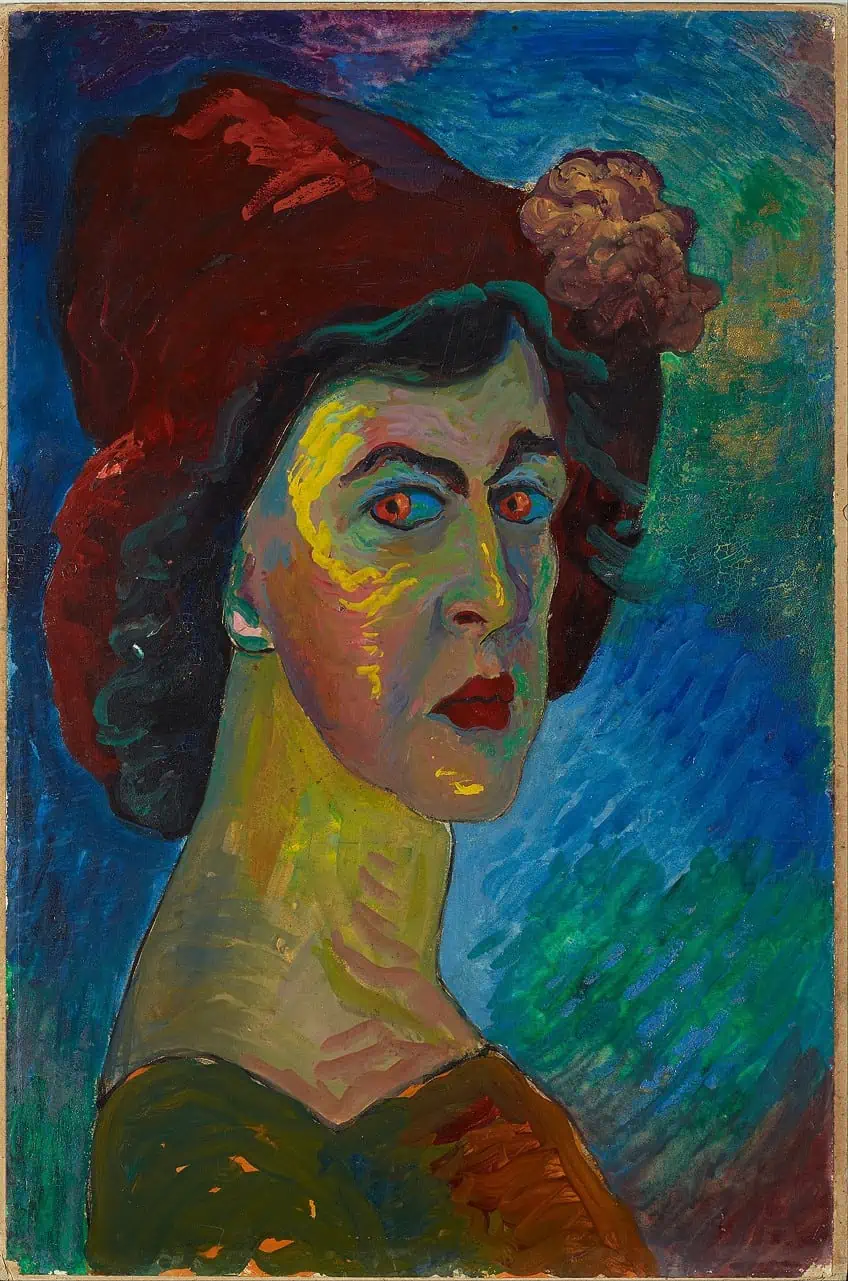
There was some level of controversy surrounding the lack of credit given to Von Werefkin following the release of Kandinsky’s publication Concerning the Spiritual on Art (1911 – 1912), where the artist claimed that Kandinsky took the credit for some of her ideas in the book. Her painting style also differed significantly from Kandinsky’s since she included human figures in their landscapes and never embraced lyrical abstraction. Instead, she directly tackled human concerns and used her Expressionist works to act as a tool for social awareness concerning urban poverty and the struggles of laborers.
Blue Horse I (1911) by Franz Marc
| Artist Name | Franz Moritz Wilhelm Marc (1880 – 1916) |
| Date | 1911 |
| Medium | Oil on canvas |
| Dimensions (cm) | 112 x 84.5 |
| Where It Is Housed | Städtische Galerie im Lenbachhaus und Kunstbau München, Munich, Germany |
Franz Marc was also another key member of Der Blaue Reiter whose striking horse paintings captured the essence of the sub-movement. Marc was also recognized by the Nazis as a “degenerate artist” since the empire was also very much against modern art and wished to suppress artists like Marc. Most of his paintings managed to survive the Second World War, which preserved many of his animal paintings from his mature period. Tragically, Marc was drafted into the army and died in battle only two years into his service at the Battle of Verdun.
Blue Horse I is part of Marc’s symbolic exploration of colors and the horse as a symbol of a breakthrough.

Similar to Kandinsky, Marc viewed the color blue as a sacred and spiritual color that was connected to his notion of the battle between spirituality and materialism. In 1910, he called for the “animalization” of modern art, which was the beginning of his most productive and successful artworks, including Blue Horse I. His use of animals in art was also an expression of harmony between the animals and their environment. By 1914, Der Balue Reiter had dissolved and Kandinsky had to return to Russia.
Four Girls (1912 – 1913) by August Macke
| Artist Name | August Macke (1887 – 1914) |
| Date | 1912 – 1913 |
| Medium | Oil on canvas |
| Dimensions (cm) | 810 x 1050 |
| Where It Is Housed | Museum Kunstpalast, Düsseldorf, Germany |
Four Girls was created by Rhineland painter August Macke a year before he died in 1914. August Macke was a key member of Der Blaue Reiter, who was greatly influenced by the Orphism works of Robert Delaunay. His style was characterized by his use of rhythmic color harmonies, which saw his negation of perspective and pure representationalism.
His paintings carried a two-dimensional ornamental aspect to them, which also alludes to the contemplation of his subjects and the use of color.
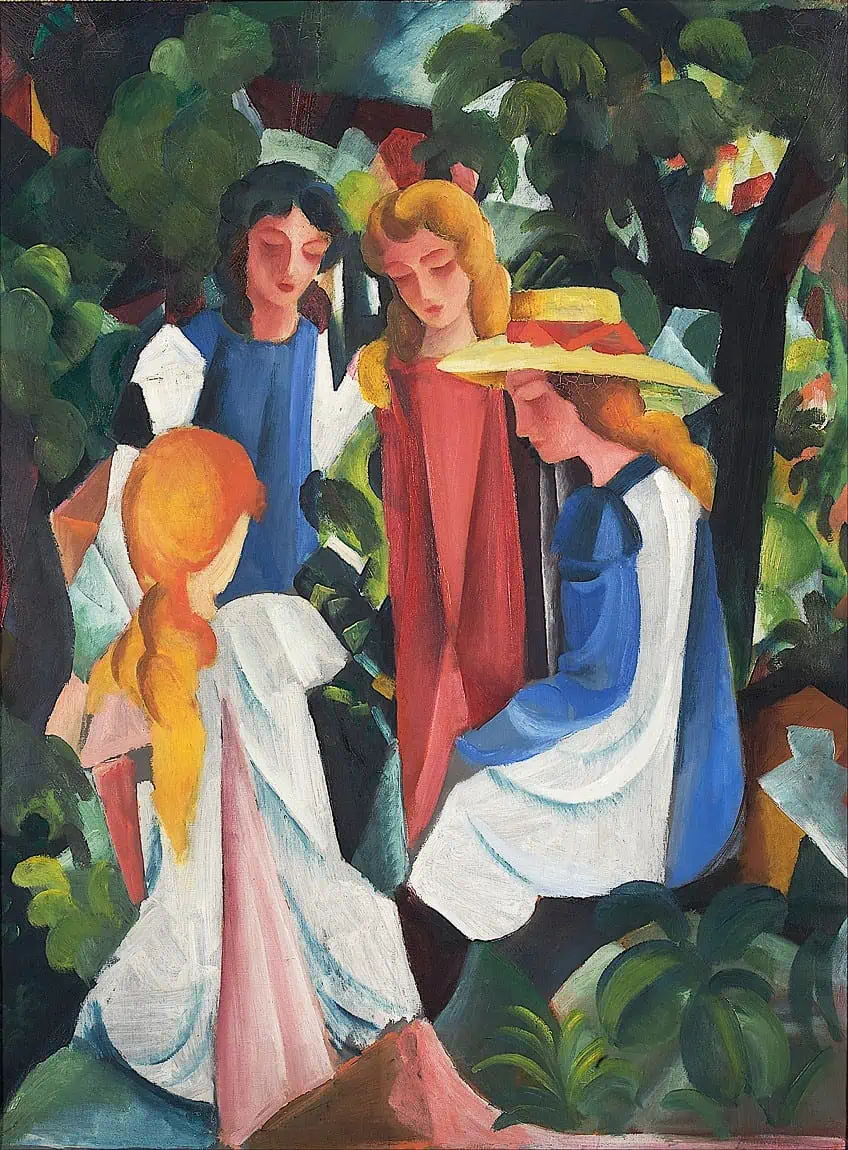
Macke studied at the Kunstakademie Düsseldorf and received art lessons from Fritz Helmut Ehmke. He later worked as a stage and costume designer for Schauspielhaus Düsseldorf and traveled across Europe before his death. Macke also accompanied Paul Klee and Louis Moilliet on a trip to Tunisia, which impacted his later approach to color and flatness in his work, as seen in Four Girls. His last painting Farewell was created just before he died in the war.
In the Style of Kairouan (1914) by Paul Klee
| Artist Name | Paul Klee (1879 – 1940) |
| Date | 1914 |
| Medium | Watercolor and pencil on paper |
| Dimensions (cm) | 44 x 46 |
| Where It Is Housed | Paul Klee Foundation, Kuntsmuseum Bern, Switzerland |
Renowned Swiss-German Abstract Expressionist Paul Klee was also a member of Der Blaue Reiter, who was already an experimental graphic designer and musician before he joined the group. His exploration of color theory emerged strongly after his interaction with the group and had evolved his palette as a colorist significantly by the 1920s. Klee was motivated by the texts written by Kandinsky, which inspired him to obsess over abstraction and increase his investment in color. His trip to Tunisia was among the most important moments for his career since it informed his understanding of color, once stating that “color possesses me”.
In the Style of Kairouan was named after a city in Tunisia and created when Klee returned to Germany. The painting is significant since it is recognized as Klee’s first painting that was executed wholly in an abstract style.
In the watercolor painting, Klee opted for geometric shapes arranged in a series of irregular polygons, circles, and rectangles that replaced recognizable imagery. Klee was born into a family of creatives, who encouraged his pursuit of music and art throughout his life. At age 11, Klee was also invited to play the violin and join the Bern Music Association for his talents in music were remarkable for his age. Klee also taught alongside Kandinsky at the Bauhaus school in Germany and went on to produce more than 10,000 artworks and many publications and books on color theory throughout the first half of the 20th century.
While these key artists of Der Blaue Reiter have made significant contributions to the German Expressionism movement, there are many other key artists that you can explore in your free time. These include figures like Alexej Georgewitsch von Jawlensky, Gabriele Münter, Robert Delaunay, Lyonel Charles Feininger, Natalia Sergeevna Goncharova, Heinrich Mathias Ernst Campendonk, and Arnold Schoenberg among other creatives who were associated with Expressionist art, music, and literature.
The Final Days of Der Blaue Reiter
How did Der Blaue Reiter end, and why? With the onset of World War I in 1914, Der Blaue Reiter was thrust into the realm of reality to face military service, and for some, be forced to return to their home countries. Artists like Werefkin, Jawlensky, and Kandinsky were deported to Russia, which saw Kandinsky accept his return to Russia while Werefkin and Jawlensky immigrated to Switzerland. Franz Marc and August Macke died in battle, with the young Macke succumbing to death after only two months of service in the war while Marc’s death was seen at the 1916 Battle of Verdun.
While the group did not endure the war, their works proved highly influential to many next-generation Expressionists and Abstract artists since the 1912 Sonderbund exhibition, which took place in Cologne and brought much recognition to Der Blaue Reiter. The group’s influence was also realized alongside Bauhaus among other talents like Johannes Itten, which eventually infiltrated the Bauhaus curriculum.
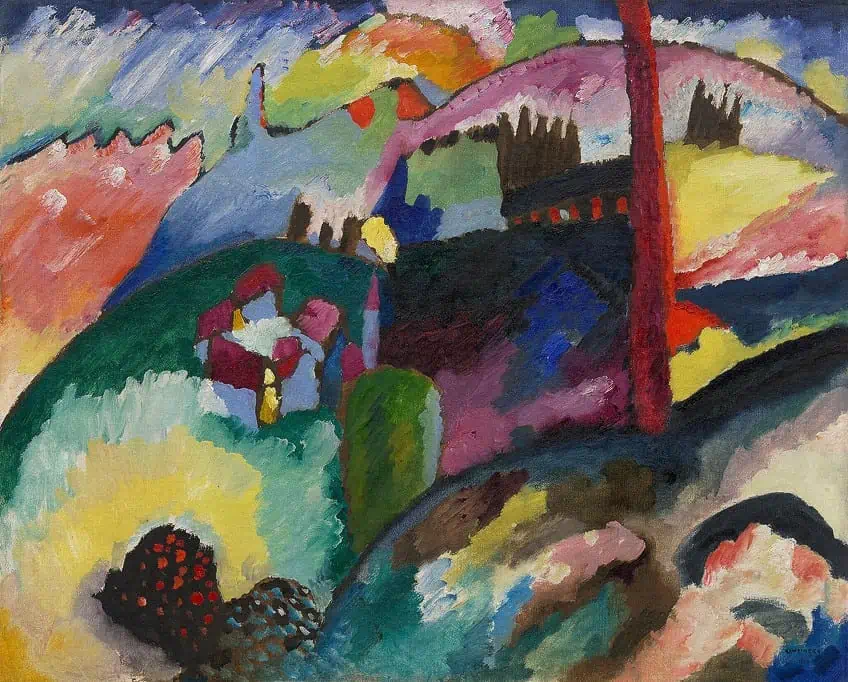
Kandinsky’s works were introduced to Western soil in the Armory Show, which fueled the development of Geometric Abstraction in the De Stijl movement. The art dealer Emmy Scheyer also helped pilot the works of artists from the group to widespread popularity after promoting their works together for close to a decade. Furthermore, the immigration of key artists like Josef Albers to the United States around the 1930s helped pave the path for Abstract Expressionists like Mark Rothko and Arshile Gorky. Today, many contemporary artists continue to reflect on the works of artists from Der Blaue Reiter, with Kandinsky and Marc leading the way in color theory and spirituality in art discourses.
Der Blaue Reiter offers much room for thought on the relationships between sound, color theory, and spirituality that invite one to ponder on the ways that we might codify our approach to abstraction. The collective efforts of these famous German Expressionists all contributed to the development of Modern Abstract art and our understanding of how spiritual subjects may find themselves in the smallest of details in our art-making processes. We encourage you to keep exploring the works of other famous German Expressionists to discover more innovative ways in which you can create interdisciplinary art like the artists of Der Blaue Reiter.
Frequently Asked Questions
What Is Der Blaue Reiter?
The 20th-century art collective known as Der Blaue Reiter translates to The Blue Rider group, and was a German Expressionist group based in Munich. The group was headed by Wassily Kandinsky and Franz Marc, alongside many other artists who shared a passion for spiritual concepts, abstraction, music, and prismatic colors to promote modern art.
Who Were the Key Artists of Der Blaue Reiter?
The main artists associated with Der Blaue Reiter include Wassily Kandinsky, Franz Marc, August Macke, Alexej von Jawlensky, Paul Klee, and Marianne von Werefkin.
Who Was the Most Famous Artist of Der Blaue Reiter?
Wassily Kandinsky, a famous Russian-German avant-garde artist, was the co-founder of Der Blaue Reiter, who was also regarded as the most famous artist of the collective. His work went on to influence teachings at the Bauhaus school, as well as many Abstract Expressionists of the 20th century.
Jordan Anthony is a Cape Town-based film photographer, curator, and arts writer. She holds a Bachelor of Art in Fine Arts from the University of the Witwatersrand, Johannesburg, where she explored themes like healing, identity, dreams, and intuitive creation in her Contemporary art practice. Jordan has collaborated with various local art institutions, including the KZNSA Gallery in Durban, the Turbine Art Fair, and the Wits Art Museum. Her photography focuses on abstract color manipulations, portraiture, candid shots, and urban landscapes. She’s intrigued by philosophy, memory, and esotericism, drawing inspiration from Surrealism, Fluxus, and ancient civilizations, as well as childhood influences and found objects. Jordan is working for artfilemagazine since 2022 and writes blog posts about art history and photography.
Learn more about Jordan Anthony and about us.
Cite this Article
Jordan, Anthony, “Der Blaue Reiter – Unveiling the Mastery Behind The Blue Rider.” artfilemagazine – Your Online Art Source. December 8, 2023. URL: https://artfilemagazine.com/der-blaue-reiter/
Anthony, J. (2023, 8 December). Der Blaue Reiter – Unveiling the Mastery Behind The Blue Rider. artfilemagazine – Your Online Art Source. https://artfilemagazine.com/der-blaue-reiter/
Anthony, Jordan. “Der Blaue Reiter – Unveiling the Mastery Behind The Blue Rider.” artfilemagazine – Your Online Art Source, December 8, 2023. https://artfilemagazine.com/der-blaue-reiter/.



